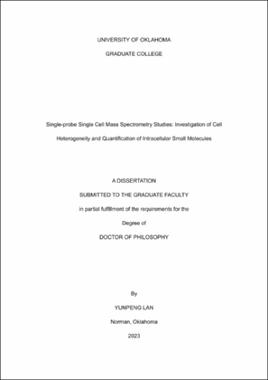| dc.description.abstract | Studying cell heterogeneity can provide a deeper understanding of biological activities, but corresponding studies cannot be performed using traditional bulk analysis methods. The development of diverse single cell bioanalysis methods is in urgent need and of great significance. Mass spectrometry (MS) has been recognized as a powerful technique for bioanalysis for its high sensitivity, wide applicability, label-free detection, and capability for quantitative analysis. The paramount significance of single cell mass spectrometry (SCMS) techniques have been recognized, and they are becoming indispensable tools in fundamental research and studies of human diseases such as cancers and infectious disease. My studies consist of two major parts: (1) the development novel method to quantify nitric oxide (NO) using combined chemical reactions and SCMS techniques and (2) the investigation of cell heterogeneity using integrated bioinformatics tools and SCMS methods.
In Chapter one, we reviewed the development of single cell mass spectrometry (SCMS) field and summarized multiple existing SCMS techniques. We also included the methods that have been used for quantitative studies of small molecules in single cells. In particular, we further developed the Single-probe, a microscale device that is ideally suited for SCMS study of live single cells under ambient environment, for molecular quantification in single cells. In Chapter two, the single-probe SCMS was coupled with chemical reactions to detect and quantify nitric oxide (NO) in single cells. We then performed detailed data analysis to study the subpopulations of cells based on their NO expression levels. In Chapter three, cellular heterogeneity in infectious disease was revealed using the Single-probe SCMS, and we discovered the bystander effect of cells, which are uninfected cells adjacent to infected cells. In Chapter four, we developed a novel data analysis method for assessing the global metabolomic profiles from the SCMS experiments, allowing us to identify subpopulations and determine the number of subpopulations without prior knowledge. Finally, in Chapter five, a new machine learning method was applied to classify cells with different drug resistant levels. | en_US |
